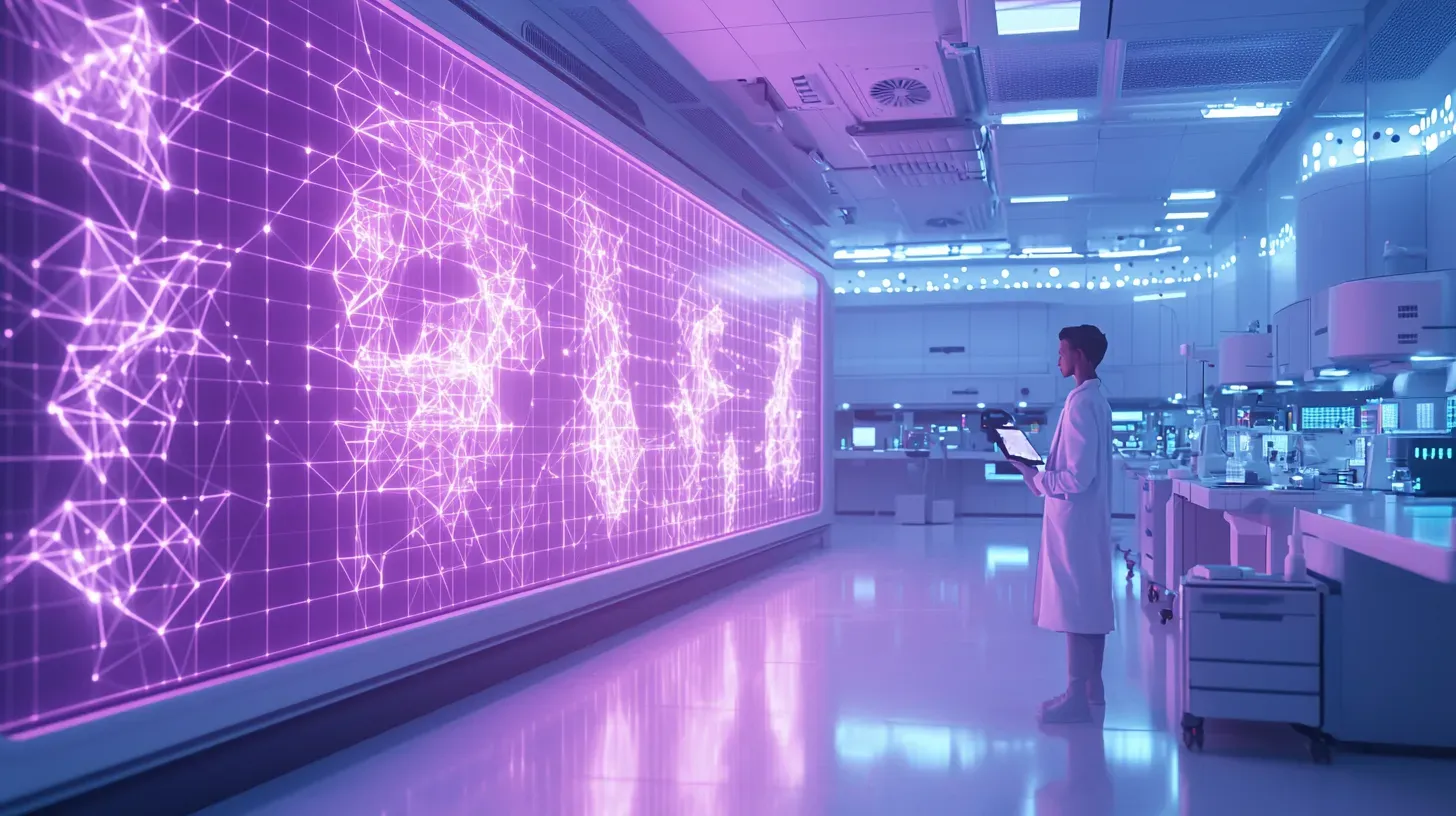An Innovation Futurist's Role in Understanding Bioinformatics

An Innovation Futurist's Role in Understanding Bioinformatics
Bioinformatics is a rapidly evolving field that sits at the intersection of biology and technology. It combines the power of computer science, data analysis, and molecular biology to unravel the mysteries hidden within our genetic code. In this article, we will explore the role of an innovation futurist in understanding bioinformatics and how they play a critical role in shaping the future of this field.
Understanding the Concept of Bioinformatics
Before delving into the role of an innovation futurist, it is important to grasp the concept of bioinformatics itself. At its core, bioinformatics is the application of computational techniques to analyze biological data. It involves collecting vast amounts of genetic and molecular information, organizing it, and extracting meaningful insights. By deciphering the complex patterns within this data, researchers can uncover vital information about genes, proteins, and other biological molecules.
One of the key aspects of bioinformatics is the utilization of algorithms and statistical models to process and interpret biological data. These algorithms are designed to handle the immense complexity and volume of genetic and molecular information. They can identify patterns, predict protein structures, and analyze gene expression levels, among many other tasks. The development of these algorithms requires a deep understanding of both biology and computer science, as well as expertise in data analysis and programming.
From the Human Genome Project to cancer research, bioinformatics has revolutionized the way we understand and approach healthcare. It enables us to diagnose diseases more accurately, develop personalized treatment plans, and even predict the likelihood of certain genetic conditions. For example, bioinformatics tools have been instrumental in identifying specific genetic mutations that increase the risk of developing certain types of cancer. This knowledge allows healthcare professionals to tailor screening and prevention strategies to individuals with a higher genetic predisposition.
Bioinformatics also plays a crucial role in drug discovery and development. By analyzing the genetic makeup of diseases and understanding the underlying molecular mechanisms, researchers can identify potential drug targets and design molecules that interact with them. This approach, known as rational drug design, has led to the development of targeted therapies that are more effective and have fewer side effects compared to traditional treatments.
Moreover, bioinformatics has paved the way for precision medicine, an approach that takes into account individual variability in genes, environment, and lifestyle when making treatment decisions. Through the analysis of genomic data, bioinformatics tools can identify biomarkers that indicate the likelihood of a positive response to a particular treatment. This allows healthcare providers to tailor therapies to individual patients, increasing the chances of successful outcomes.
As technology continues to advance, bioinformatics is poised to play an even greater role in healthcare and beyond. The integration of artificial intelligence and machine learning algorithms with bioinformatics has the potential to accelerate the discovery of new drugs, improve disease diagnosis, and enhance our understanding of complex biological systems. Furthermore, bioinformatics is not limited to human health but extends to areas such as agriculture, environmental science, and evolutionary biology.
This field holds immense potential for transforming the healthcare landscape, and it is the role of an innovation futurist to stay ahead of the curve. By keeping abreast of the latest advancements in bioinformatics and understanding their implications, innovation futurists can guide organizations and policymakers in harnessing the power of this field to drive positive change. They can identify emerging trends, anticipate challenges, and propose innovative solutions that leverage bioinformatics to improve healthcare outcomes and shape the future of medicine.
The Role of an Innovation Futurist in Bioinformatics
An innovation futurist is someone who thrives on anticipating and embracing emerging technologies. They have a unique ability to envision the future and understand how different disciplines intersect to drive innovation. In the context of bioinformatics, an innovation futurist plays a crucial role in bridging the gap between biology and technology.
By staying up to date with the latest advancements in both fields, an innovation futurist can identify opportunities for collaboration and identify innovative solutions to complex problems. They can bring a fresh perspective to bioinformatics research, pushing the boundaries of what is currently possible and paving the way for future breakthroughs.
One of the key responsibilities of an innovation futurist in bioinformatics is to explore the potential of emerging technologies in the field. This involves closely monitoring the latest developments in areas such as artificial intelligence, machine learning, and data analytics. By understanding how these technologies can be applied to bioinformatics, the futurist can identify new avenues for research and development.
For example, imagine a scenario where a new machine learning algorithm is developed that has the potential to analyze vast amounts of genomic data in a fraction of the time it currently takes. An innovation futurist would recognize the significance of this advancement and work with bioinformatics researchers to explore its applications. They would collaborate with experts in both fields to design experiments and develop algorithms that leverage this technology to accelerate the discovery of new insights in genomics.
In addition to exploring emerging technologies, an innovation futurist also plays a vital role in fostering interdisciplinary collaborations. They act as a bridge between biologists, computer scientists, statisticians, and other experts, facilitating communication and knowledge sharing. By bringing together diverse perspectives and skill sets, the futurist can spark innovative ideas and approaches that may not have been possible otherwise.
Furthermore, an innovation futurist in bioinformatics is constantly seeking out new research opportunities and funding sources. They actively engage with industry leaders, government agencies, and academic institutions to identify potential partnerships and secure funding for innovative projects. This involves networking, attending conferences and workshops, and staying connected with the latest trends and funding opportunities in both biology and technology.
Overall, the role of an innovation futurist in bioinformatics is multifaceted and dynamic. They are constantly pushing the boundaries of what is possible, leveraging emerging technologies, fostering collaborations, and seeking out new research opportunities. By embracing the future and bridging the gap between biology and technology, they are instrumental in driving innovation and shaping the future of bioinformatics.
The Intersection of Biology and Technology
The marriage of biology and technology in bioinformatics opens up a world of possibilities. From the computational analysis of DNA sequences to the development of new algorithms for data interpretation, the synergy between these two fields is truly remarkable.
An innovation futurist recognizes the immense potential of this convergence and explores ways to harness it. By delving deeper into the intersection of biology and technology, we can uncover fascinating applications that have the potential to revolutionize the field of bioinformatics.
One such application that an innovation futurist might explore is the use of artificial intelligence (AI) and machine learning algorithms to analyze genomic data. These algorithms have the ability to spot trends and patterns that human researchers might miss, leading to more accurate diagnoses and tailored treatment plans.
Imagine a scenario where a patient's genomic data is fed into a sophisticated AI system. The AI system, armed with powerful algorithms, can quickly analyze the data and identify genetic variations that may be linked to certain diseases or conditions. This information can then be used to develop personalized treatment plans that target the specific genetic factors contributing to the patient's health issues.
Furthermore, the integration of technology in bioinformatics can also lead to advancements in drug discovery and development. Traditional methods of drug discovery can be time-consuming and costly, often requiring years of research and testing. However, with the aid of technology, an innovation futurist can explore new avenues for accelerating this process.
For example, virtual screening techniques can be employed to rapidly identify potential drug candidates. By utilizing computational models and algorithms, researchers can analyze vast databases of chemical compounds and predict their potential efficacy and safety profiles. This allows for a more efficient and targeted approach to drug discovery, ultimately leading to the development of novel therapeutics.
Moreover, the integration of biology and technology can also extend to the field of personalized medicine. With advancements in genomic sequencing technologies, it is now possible to obtain an individual's complete genetic information. This wealth of data can be utilized to develop personalized treatment plans that take into account an individual's unique genetic makeup.
By leveraging technology to enhance biological research, an innovation futurist can accelerate progress and drive innovation in bioinformatics. The possibilities are endless, and the continued exploration of the intersection between biology and technology holds great promise for the future of healthcare.
How an Innovation Futurist Forecasts Trends in Bioinformatics
One of the key roles of an innovation futurist in understanding bioinformatics is forecasting trends in the field. By analyzing current research, technological developments, and societal needs, they can anticipate the direction that bioinformatics is heading. This foresight allows them to make informed decisions and guide research efforts towards promising areas.
When it comes to bioinformatics, the innovation futurist delves deep into the realm of precision medicine. They observe the growing importance of this field, where treatments are tailored to an individual's unique genetic makeup. With the increasing availability of genomic data, the innovation futurist recognizes the potential for a revolution in healthcare.
As the innovation futurist looks ahead, they anticipate that incorporating this wealth of genomic data into healthcare decisions will become increasingly significant. They envision a future where personalized treatment plans are the norm, where doctors can analyze a patient's genetic profile to determine the most effective course of action. This tailored approach has the potential to improve patient outcomes and revolutionize the way we think about healthcare.
To make this vision a reality, the innovation futurist advocates for the development of tools and algorithms that can make sense of the vast amount of genomic data. They recognize that the sheer volume of information can be overwhelming, but with the right tools, patterns and insights can be extracted. These tools could include advanced machine learning algorithms that can analyze genetic data and identify potential disease markers, or sophisticated visualization techniques that can help researchers interpret complex genomic information.
Furthermore, the innovation futurist understands that bioinformatics is not just about the data itself, but also about how it is used and shared. They foresee a future where collaboration and data sharing are paramount, where researchers from different disciplines come together to tackle complex biological problems. They advocate for the development of secure and efficient data sharing platforms that enable scientists to collaborate seamlessly, accelerating the pace of discovery and innovation.
As the innovation futurist continues to forecast trends in bioinformatics, they keep a close eye on emerging technologies. They recognize the potential of emerging fields such as synthetic biology and gene editing, and how these advancements could further transform the field of bioinformatics. By staying at the forefront of technological developments, the innovation futurist ensures that their forecasts are grounded in the most up-to-date knowledge and insights.
Practical Applications of Bioinformatics in Healthcare
Bioinformatics has already made significant strides in transforming healthcare. By analyzing genetic data, bioinformatics tools can identify disease risks, detect genetic mutations, and inform treatment strategies. These practical applications have the potential to revolutionize patient care and improve healthcare outcomes.
Take, for example, the field of pharmacogenomics. By examining an individual's genetic makeup, bioinformatics can help determine the most effective medications and dosages for specific patients. This personalized approach minimizes adverse side effects, enhances treatment efficacy, and ensures that patients receive the right drug, at the right dose, and at the right time.
Furthermore, bioinformatics plays a crucial role in the development of targeted therapies. By analyzing genomic data from tumor samples, researchers can identify specific genetic mutations that drive cancer growth. This knowledge enables the design of drugs that selectively target these mutations, resulting in more effective and personalized cancer treatments.
Conclusion
In conclusion, an innovation futurist's role in understanding bioinformatics is vital in driving innovation, discovering new solutions, and shaping the future of this interdisciplinary field. By recognizing the potential of technology to transform biology and foreseeing emerging trends, they play a critical role in pushing the boundaries of bioinformatics research. They bring their unique perspective to foster collaboration, develop cutting-edge algorithms, and uncover the hidden treasures encoded in our genes. With their guidance, bioinformatics holds the promise of revolutionizing healthcare and unlocking the secrets of life itself.
FAQ
1. What is bioinformatics?
Bioinformatics is the application of computational techniques to analyze biological data, such as genetic and molecular information. It involves the use of algorithms and statistical models to process and interpret this data, extracting meaningful insights about genes, proteins, and other biological molecules.
2. How does bioinformatics contribute to healthcare?
Bioinformatics has revolutionized healthcare by enabling more accurate disease diagnosis, personalized treatment plans, and the development of targeted therapies. It allows healthcare professionals to identify genetic mutations that increase the risk of certain diseases, tailor screening and prevention strategies, and design drugs that interact with specific molecular targets.
3. What is the role of an innovation futurist in bioinformatics?
An innovation futurist in bioinformatics plays a crucial role in bridging the gap between biology and technology. They explore emerging technologies, foster interdisciplinary collaborations, and forecast trends in the field. By staying ahead of the curve, they guide organizations and policymakers in harnessing the power of bioinformatics to drive positive change in healthcare and shape the future of medicine.
Contact a Innovation Futurist for your event
Are you ready to explore the future of bioinformatics at your next event? Dr Mark van Rijmenam, a renowned Innovation Futurist, is available to bring his expert insights and foresight to your audience. With his deep understanding of the intersection of biology and technology, Dr van Rijmenam can guide your attendees through the fascinating world of bioinformatics, illuminating its potential to revolutionize healthcare and beyond. His engaging talks will not only educate but also inspire your audience to embrace the future of this rapidly evolving field. Don't miss the opportunity to have Dr van Rijmenam at your event. Simply complete the form below and we will be in touch within 24 hours. Let's shape the future of bioinformatics together!
Thanks for your inquiry
We have sent you a copy of your request and we will be in touch within 24 hours on business days.
If you do not receive an email from us by then, please check your spam mailbox and whitelist email addresses from @thedigitalspeaker.com.
In the meantime, feel free to learn more about The Digital Speaker here.
Or read The Digital Speaker's latest articles here.





